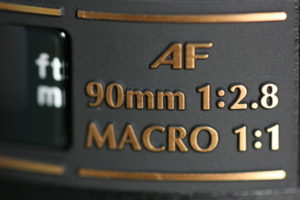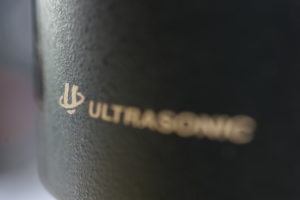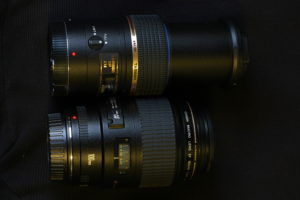The macro is a fairly popular field, and often comes the moment when the photographer wonders what macro lens to buy. A 100 mm seems like a good start, but of all these models, how do you know which one is the best? That’s what I’ve been trying to figure out in partnership with Geek Trend.
Indeed, I too was wondering about that. I wanted to try my hand at macro, and among the Canon Macro lenses I was hesitating between the different 100mm (or almost) macro lenses that exist. The excellent Canon 100mm f/2.8 Macro L IS USM being clearly out of my purse’s reach, even if it remains at a relatively reasonable price considering the quality of the stone, according to all the tests.
So I made contact with Geek Trend (whom I thank warmly for their confidence), who have therefore very kindly offered to lend me both the Canon EF 100mm f2.8 Macro USM and the Tamron 90mmThis is a serious competitor for a much lower price. After a very good contact with the team of Geek Trend and a lightning delivery…here I am with these two lenses in my hands.
![]()
The goal is not to make extensive tests on the optical quality of the two pebbles, which requires particular technical means, and already exists anyway (general result: there is no significant difference in quality between the 2 objectives). In short, I’ll focus more on an general feelingto a vision a little more subjectivewhile trying to bring out the qualities and the defects from every angle. Accuracy: all tests were performed with my Canon EOS 450D.


Manufacturing quality, ergonomics, etc…
When I unpacked the 2 lenses (at least if I had bought them :P), I still had a slight feeling that Canon is making fun of its customers. Tamron offers a warm lens in an cover and with a sun visorwhile Canon wraps it up in Styrofoam, and of course… without sunshade. After all, for an extra 100 euros…
Well, let’s ignore this propensity of the red brand to scratch the price of a sun visor on €500 optics 😛
Both optics offer a magnification ratio of 1:1, i.e. the objects have the same size on the sensor as in reality. Example: if you photograph a flower that is 5mm wide in reality, it will be 5mm on your sensor.
Both objectives seem to be really well constructed, solidsand hold on tight. The Cannon is slightly heavier (600g vs. 405g anyway), which can be seen as an advantage or disadvantage. The weight provides a little more stability in hand and an overall impression of robustness (he’s more “trusted”), but at the same time… weighs out of the bag. But the difference isn’t obvious at every moment either, let’s put it into perspective.
The front lens is more exposed on the Canon (a sun visor would have been useful for this), and more recessed on the Tamron (so much so that one wonders what the sun visor is for :P).
On the other hand, ergonomic defect that I find borderline on the Tamron: when the lens hood is mounted but “upside down” (i.e. just to keep it on the optics) and the focus is close to infinity, the focusing ring is simply inaccessibleThis is especially useful if you want to return to manual focus. Well, we rarely get in this situation and you just have to take off the sun visor, but that’s the kind of thing you pay attention to, isn’t it?
Concerning the focusing rings precisely, they are both really excellent soft, precise, hold well in hand. On this point, Tamron is doing well… just as well than Canon.
On the other hand, Canon proposes a constant manual focus (“Full Time Manual”), which means that even in AutoFocus, you can resume focusing manually at all times. This really increases the comfort of use! That said, Tamron offers the option of switching to manual focusing very simply by pulling the focus ring towards you: a rather efficient and intuitive that I didn’t know.
The focus close that the macro implies often poses the problem of having the autofocus that “slips”, i.e. it will try to focus to infinity and then come back to the minimum distance several times, which clearly takes awesome. Both lenses pose this problem which is anyway inherent to macro if you don’t have a very efficient autofocus system, if you lack a little light, etc….
Both brands offer a different system to assist the lens: Canon offers a button that allows you to set the focus distance to 0.31 m to infinity (i.e. on all the focus range), or on the contrary of 0.48m to infinity (if your subject is further away). Only problem: it doesn’t help on related topics 😛
Tamron has a different system that I find smarter for the move: a cursor “Limit“or”Full“. On Full, you can set 0.29m to infinityand on Limit it depends on where the focus is made. If it’s done between 0.29 and 0.4m and you set the slider to Limit you will be limited to this focus range, and the same goes for a distance between 0.45 and infinity. So you have to switch back to Full (or manual focus) to go from one range to the other. It may not seem intuitive like that, but I think it’s an excellent system once you get used to it (and it was present on the Canon’s predecessor, by the way).
Macro behaviour
Both lenses are really excellent. The optical quality is clearly there, with a excellent piqué and a nice bokeh (respectively 8 and 9 diaphragm blades for the Canon and Tamron ). Look at the 2 pictures below, both taken at 1/1 ratio. They are certainly not professional lenses (although we are not that far from it), but it will change you from your 18-55 😉


Autofocus is quickwith, however, a slight advantage on this point for the Canon at short distance (at more than 1m I did not see any obvious difference), probably thanks to the ultrasonic motorization.
But in any case, given the extremely high depth of field reduced in macro (remember that this decreases with the distance to the subject), it is rigorously impossible to produce clean shots without tripod. Indeed, as soon as you move, your subject is very easily found. without of the sharpness area, which can be less than 1mm at full aperture and minimum focusing distance!
So we’re working on a tripod, in manual focus most often, especially on moving subjects, and most of the time we close to f/8 at least (although it’s a lot of fun to play with the ridiculous depths of field produced at f/2.8).


(These two pictures were taken at f/4, and you can see that at these apertures, the depth of field is very small! By the way, these two pictures have obviously undergone some post-processing, not all is due to the magic of the lens :P)
There are still 2 fundamental differences that must justify the higher price of the Canon:
- this one does not lie down when focusingwhile the Tamron does. This could clearly scare insects for example, which is annoying for a macro lens, you will admit it to me 😛
Having said that, I could easily be told that our movements are probably scarier, and that to photograph insects, you either have to choose a longer focal length (the Sigma 150mm macro for example) or choose a time when they are immobilized (in the early morning for example).
- The ultrasonic focusing (and therefore silent) of the Canon. Here too, the noise can frighten away the bugs. But the same counter-arguments as before 😉

In other words, if you want to do macro, you don’t need to think about buying one of these optics before you have an tripodI’m warning you 😉
Versatile optics
It will not have escaped you that they are certainly macro optics, but also optics that open a lot (f/2.8) and a fairly long focal length, and are therefore able to handle situations of low light or fromisolate a subject (or both). It was too tempting, I had to test them in other areas than the macro 😀
I had the chance to photograph a theatre company as I mentioned in a previous article, so I shot 2 of their performances. Very little light (I had to shoot on a tripod!), a very silentin short, quite difficult conditions.
The following week I also had the opportunity to get my hands on a dance show, also relatively quiet (if you’re curious about the result, the pictures of these 2 events are on my Flickr gallery 😉 ).
And now, I have to admit that the ultra-sonic motorization has given me saved life. I mean, I don’t even have Daring take the Tamron out to the theater, because the focus is really noisy (it has to be said), while she’s actually inaudible on the Canon (at the beginning I even wondered if it was working well :P). Well it’s a very special case that you probably won’t have to face, but I’ll tell you about it anyway 😉
In any case, both optics are doing fine. perfectly for a tune-up quick and says in low light, and isolate the subject very well. Unfortunately, I didn’t have the opportunity to test them in portrait, but they are 2 excellent lenses for this domain, no doubt about it (I mean, a 100 mm focal length that opens at f/2.8 and good optical quality, it makes nice portraits, it’s obvious).
My general feeling
I think it’s been obvious from the beginning of this test: the two lenses are the same in many ways:
- optical quality
- quality of manufacture
- autofocus
- focusing ring
On a more subjective level, I feel a little more comfortable with the Canonand I’m getting more. pleasure (which is very important but totally subjective and very different from person to person). If you think about it carefully and eliminate the “it’s a quasi pro **bave** quality Canon” effect, I think it’s mainly due to the ultrasonic motorizationvery comfortable and a little faster, and at the constant manual focus (FTM) which brings real comfort in macro.
But quite frankly, the Tamron is also a very good lens, and if you’re 100€ short of budget for the Canon, don’t hesitate one second and run out and buy that rock, you won’t regret it. And if you’re not at Canon’s, then the choice is made! 😛
But beware, you quickly get used to optics of this quality ;D
I didn’t test the Sigma 105mm Macro simply because it’s already quite good that Geek Trend trusted me by lending me 900€ of material for a first contact ^^
I take this opportunity to renew my thanks to Geek Trend for trusting me and lending me these two lenses!
I hope that this test will have guided you in the purchase of an 100mm (or almost) macroand as I am led to test other optics, do not hesitate to make suggestions in the comments 😉.
Note: all the links in this article pointing to Geek Trend are affiliate links, which means that if you buy material from them by following these links, I will earn a small commission that allows me to continue to offer you content each week. For example, I would never have been able to write the article on the 3 difficulties of the macro without the loan of these objectives! Thanks to you 😉
And don’t forget to share the article! 🙂




Discussion about this post